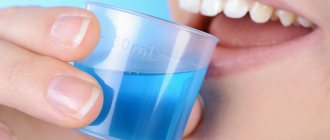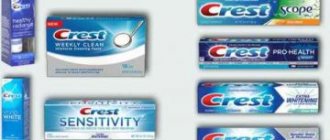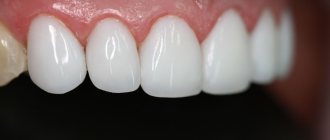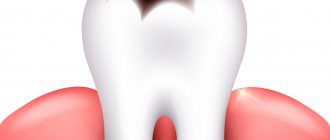Sealing is the filling of the grooves in the teeth with a special composition that allows them to block the proliferation of pathogenic microorganisms.
The grooves in the teeth are called “fissures” and are characteristic mainly of the posterior chewing teeth - molars. They are very thin, and the bristles of the brush are not able to clean everything that is at the bottom of the fissures. As a result of lack of regular brushing, plaque can accumulate in a child's teeth, which will subsequently destroy the enamel, cause tooth decay, and possibly destroy a once perfectly healthy tooth.
What are dental fissures
There are fissures on both baby teeth and permanent teeth.
These are physiological folds - grooves, dimples and depressions - on the chewing surface of molars and premolars. The incisors and canines do not have fissures. Such cavities easily and quickly fill with plaque, are poorly cleaned with toothpaste and a brush - they become a common cause of carious lesions. Pediatric dentists often suggest sealing fissures - creating a thin film on the surface of the crown that will protect against pathogenic microflora and mechanical damage.
There are two main reasons for fissure sealing:
- Children's inability to take good care of their teeth. Even the most responsible child is not able to clean all the cavities on the surface of molars and premolars, which leads to the development of caries and the need for treatment. Especially if the grooves differ in depth and tortuosity.
- Thin enamel of teeth - milk and permanent during the period of change of bite. The thickness of the enamel of temporary units is half that of permanent ones, which explains its rapid destruction and susceptibility to caries. During eruption, molars are especially vulnerable - initially the crowns are covered with thin, slightly mineralized enamel, and only after 2-3 years the surface becomes resistant to external damage.
Rodikova Tatyana
Before recommending invasive fissure sealing to a patient, I always look at the initial level of mineralization. With a high mineral content and wide grooves, sealing cavities can be easily done without sealing, but there are cases (low mineralization, prone to caries) when sealing the teeth is the best option!
What material is the sealant made of?
To seal fissures, special dental sealants are used, which are characterized by good fluidity, allowing them to penetrate even the smallest crevices of the tooth surface. Essentially, these are modern polymers based on methacrylate and polyurethane. Each of them has its own properties, wear resistance, and can harden naturally or under the influence of a UV lamp. Often their composition is additionally enriched with fluoride ions, which strengthens tooth enamel, thereby inhibiting the development of the carious process.
Sealants for sealing fissures differ not only in their composition, but also in their transparency.
- Transparent sealants
allow you to visually monitor the condition of fissures. But due to their colorlessness, they are practically invisible on the surface of the tooth, which makes it difficult to assess the condition of the sealant itself. - Opaque sealants
are sealants that contain titanium dioxide. They are painted in a pleasant milky white color, are hardly noticeable on the chewing surface of the teeth and allow you to monitor the general condition of the sealant during use.
Any sealant composition is well tolerated by the human body, does not cause allergic reactions and does not harm tooth enamel.
Treatment of baby teeth against caries: indications
Typically, fissure sealing is carried out at the request of the parents. But sometimes dentists recommend the procedure, since sealing fissures reduces the risk of developing caries in milk and permanent teeth. The indications are:
- Young age of the patient. The enamel of newly erupted teeth has a thin layer. It is not sufficiently saturated with fluorine and calcium and is susceptible to destruction.
- Pathologically thin enamel. Sometimes the structure of tooth enamel does not change over time - it remains thin and susceptible to microorganisms.
- Curvy and narrow grooves on the teeth. The complex shape makes daily high-quality teeth cleaning impossible.
- Malocclusion and abnormal position of molars and premolars.
- Insufficient oral hygiene.
- Primary signs of enamel demineralization are stains on the tooth surface and superficial caries.
Among the contraindications:
- Carious lesions - sealing is allowed after dental treatment.
- Wide and open fissures - accessible for everyday high-quality cleaning with toothpaste.
- Allergy to sealant coating - instead of sealing, enamel silvering, remineralization, and fluoridation are available.
- Heavy salivation.
- Long-term eruption of a baby or permanent tooth – more than 4 years ago.
Modern sealing methods
The fissure sealing procedure begins with a thorough diagnosis of the general condition of the oral cavity. During its implementation, specialists from the Dental Center on Shabolovka assess the condition of the tooth enamel, the presence or absence of a carious process, the depth and structure of the fissures themselves. After this, one of the methods of sealing the tooth grooves will be selected - non-invasive or invasive.
- A non-invasive sealing technique
is used for open fissures. It does not involve additional opening of natural grooves, and comes down to simply filling visible gaps with dental sealant. - The invasive technique
is used in the presence of deep or closed fissures, the condition of which cannot be monitored visually. To do this, they are first “opened” and then sealed with sealant.
Both sealing methods are safe for the patient's health. At the same time, the non-invasive technique is absolutely painless and does not require the use of anesthesia. While during invasive sealing, the patient may experience discomfort and unpleasant sensations caused by micropreparation of the surface tissues of the tooth. Therefore, the procedure can be performed using local anesthesia, which eliminates any pain.
Seal your child’s teeth from caries: how fissure sealing is carried out
Fissure sealing is a painless and short procedure. To carry it out, a “sealant” material, a fissure sealant, is used. Sealant is a high-strength composite composition that hardens under the influence of light. Its feature is increased fluidity, thanks to which the sealant is able to fill even hard-to-reach places on the tooth crown. Also among the advantages of the sealant:
- Waterproof – resistant to saliva.
- Durability – the coating lasts on the teeth for up to 5 years.
- Aesthetics - sealants are produced in transparent, beige, and colored.
Stages of fissure sealing of primary and permanent teeth:
- Removing plaque from enamel and all cavities. Polishing the crown surface.
- Treatment with an antiseptic composition.
- Drying teeth and protecting the treated unit from the influence of saliva.
- Application of acid gel to enhance adhesion and create a slightly rough surface.
- Rinse off the composition and dry the tooth.
- Filling fissures with liquid sealant - applying sealant.
- Creating conditions for hardening - chemical activation or using a light lamp.
- Removing excess material.
- Coating the tooth with a fluoride-containing strengthening gel.
The optimal age of a child for fissure sealing is 6-8 years. During this period, the first permanent molars erupt and need protection. The procedure is indicated for children aged 1.5-2 years, and adolescents aged 12-14 years. The appearance of any wide tooth is a reason to carry out dental sealing and reliably protect the enamel from destruction for several years.
Plaksina Margarita
I am often asked what they cover children's teeth with to protect them from caries. At Aza&Buka we use sealants - special gels. They not only seal the surface of the tooth, but also strengthen the enamel by releasing fluoride ions.
Important: materials for fissure sealing
Materials for fissure sealing are divided into 3 groups: composite (chemical or light curing), glass ionomer cement and compomer. What is the difference between them...
- Composite materials – these materials are made from a special composite resin and can be cured either with light or chemically. Materials of this class are divided into 2 subgroups: unfilled and filled sealants. The former have high fluidity, and therefore penetrate even the narrowest and deepest fissures; in addition, they adhere more tightly to the enamel surface, but wear out faster and require replacement.
Filled sealants have less fluidity and penetration depth, and therefore they are more often used for invasive fissure sealing technology (see below). Their disadvantage is also their high sensitivity to moisture and complex application technology. Pros: high abrasion resistance.Important: this class of materials allows you to protect your teeth from fissure caries for a long time (up to 5-8 years). The degree of preservation of the composite sealant 3 years after application is up to 90%. The best composite sealants include the following 3rd generation light-curing sealants: “Fissurit”, “Helioseal”, “Estisial LC” and especially those containing fluorine – “Fissurit F” and “Admira Seal”. The release of fluoride from Fissurit F continues for more than 190 days from the moment of application!
- Glass ionomer cements (GIC) – these materials have a pronounced cariesstatic effect due to the presence of aluminum, zinc, calcium, and especially due to the fluorine content. These materials are chemically cured; a big plus is that they do not require etching of the enamel with 38% acid before application (unlike composite materials).
Compared to composite materials, GICs have low fluidity, which does not allow their use in deep fissures without opening them with a drill, and also have a greater degree of edge leakage and wear out faster. There is an opinion that the use of GIC as fissure sealants is justified when it comes exclusively to newly erupted teeth (with extremely low mineralization of fissure enamel). In the latter case, it is not advisable to etch the enamel with acid, and for the use of composites, the enamel must always be etched.The safety of GIC 1, 6, 12 and 24 months after application is 90, 80, 60 and 20%, respectively, and after 3 years it is only 10% (in turn, the composite sealant is 90%). However, this class of materials reduces the occurrence of caries in fissures by 80-90% in 2 years. The following materials belong to GIC: “Dyract seal”, “Fuji”, “Glass Ionomer”, “Aqua Ionoseal”...
- Compomers - they are classified as light-hardening composite materials, however, components have been added to their composition that give them the positive properties of glass ionomer cements.
Advantages compared to traditional composites: greater tolerance to humid environments, greater fluidity and the ability to release fluoride in small quantities. It should be noted that these advantages had to be paid for with a greater degree of abrasion (in 2 years the compomer almost completely disappears). Materials of this class include “Dyrect Seal” (Dentsply).
The effectiveness of sealants: conclusions
Comparative results of a study of different methods of caries prevention showed that the method of sealing dental fissures is the most effective. Patients who had their fissures sealed experienced a 92.5% reduction in caries growth during the first year compared to patients who did not have their fissures sealed. For example, if caries prevention is carried out only by treating teeth with fluoride-containing varnish (once a year), this reduces the increase in caries only to 70%.
A one-time sealing of dental fissures is guaranteed to be effective for an average of up to 5 years, but can retain its properties for up to 10 years (this also occurs by increasing the resistance of fissure enamel to caries due to the release of fluoride ions by the material). Research shows that after 7 years of fissure sealing with composite materials, about 49% of fissures are still sealed.
The best material: Composites are undoubtedly the most effective materials, but when it comes to sealing fissures in newly erupted teeth (the enamel of which has extremely weak mineralization), then glass ionomer cement should be preferred. Also, preference should be given to glass ionomer cements when sealing fissures in children with little contact, for whom it is difficult to achieve good isolation of the tooth surface from saliva. We hope that our article on the topic: Fissure sealing in children, pros and cons, was useful to you!
Sources:
1. Higher professional education of the author in dentistry, 2. Personal experience as a dental therapist, 3. The European Academy of Paediatric Dentistry (USA), 4. National Library of Medicine (USA), 5. “Pediatric therapeutic dentistry. National leadership" (Leontyev V.).
Methods for filling children's teeth against caries
There are different ways to seal baby and permanent teeth. In the capital's dentistry they offer:
- Non-invasive sealing - the procedure is carried out without compromising the integrity and structure of the tooth. The method is suitable for healthy teeth with a wide distance between the cusps on the crown. The doctor sequentially applies the compounds, closing and protecting the cavities.
- Invasive sealing - the doctor processes the enamel for better access to hidden areas on the surface of the molar in the presence of narrow and deep fissures. The procedure is also indicated if it is necessary to treat caries.
Dolotova Marina
Experience shows that sealing fissures reduces the risk of developing caries several times. This can be seen if we observe patients with a similar enamel structure and attitude towards dentistry. Children with sealed fissures keep their teeth intact and healthy for a long time.
Fissure sealing in children: price 2021
In economy-class and mid-price clinics, fissure sealing in children will cost from 600 to 1,200 rubles per tooth. This difference in cost will depend on the type of material used to seal the fissures, as well as on the sealing technique (each of which has its own indications for use).
There are 2 methods: non-invasive sealing of fissures (without opening them with a drill) will be cheaper. But if you have narrow, deep fissures that will need to be opened with a drill before applying the material, the price will be around 1,200 rubles without the cost of anesthesia (the cost of anesthesia will be about another 300 rubles).
How to protect baby teeth from caries
Fissure sealing is an effective method of caries prevention. But you can't rely on the dental procedure alone. To maintain and preserve the health of children's teeth it is also necessary:
- Proper nutrition - more solid vegetables and fruits, fermented milk and dairy products, minimizing sweets.
- Systematic dental care - you need to brush your teeth twice a day, and when correcting your bite with braces, after every meal.
- Scheduled visits to the doctor - dentists invite you for an appointment every six months, and sometimes more often.
- Selection of toothpaste and toothbrushes according to age - when purchasing care products, you should focus on the dentist’s recommendations.
Pediatric dentistry today offers non-invasive and invasive techniques for fissure sealing. When choosing a doctor, you should focus on the dentist’s experience, reviews and recommendations. To increase the effectiveness of the procedure, make an appointment immediately after the chewing surface has erupted - when the crown becomes visible and accessible for treatment.
Prevention
According to statistics, 80% of sealants retain their integrity and tightness for 2 to 3 years after the procedure. Over the next 5–7 years, about 70% of sealants successfully withstand. After 10 years, only 30% of sealants remain intact and functional. Thus, modern sealants can serve the patient for a long time. The main thing is to undergo preventive examinations at the dentist in a timely manner and monitor their condition. To do this, you need to visit a specialist at least 1–2 times a year and regularly inspect the sealed fissures yourself. If you notice that part of the sealant has fallen out, you should immediately contact your doctor. Otherwise, it is enough to adhere to the general recommendations of a specialist and pay due attention to daily oral hygiene.
Author: Elena Kopylova Dentist-therapist, endodontist, pediatric dentist. Work experience more than 7 years.
The information is for reference only. Before treatment, consultation with a doctor is necessary.
Arguments for sealing teeth
Coating with a sealant helps preserve teeth during the critical period of enamel maturation and avoid costly treatment in the future. Compare, the price of sealing a tooth fissure is from 20 rubles, the cost of caries treatment is from 85 rubles. The procedure is simple and painless, so most parents agree to this type of prevention.
The parents of young patients, who were convinced of the positive results of sealing the chewing teeth previously carried out in older children, have no doubt about the benefits of fissure sealing. During preventive examinations, our doctors notice that 15-16 year old teenagers do not develop fissure caries on teeth that have been sealed after teething. While teeth that are not covered with sealant have to be treated already at 7-8 years of age.
Photocurable composites are now used to seal fissures in dentistry. The materials have good thixotropic properties - when leaving the cannula of the syringe, the sealant becomes fluid, penetrates into small recesses, fits tightly, and hardens under a polymerization lamp. After polishing, the applied layer becomes glossy, and plaque does not attach to it.
Sealants are enriched with fluorides, which form fluorapatites that reduce enamel permeability. The minerals are more resistant to acidic environments and less soluble than hydroxyapatite (the main component of enamel). Long-term release of fluoride ions improves the crystal structure of enamel during maturation, reduces the number of cariogenic bacteria in plaque, and suppresses acid formation.
Fluoride-containing sealants strengthen and protect the fragile fissure enamel during the maturation period. Give your teething teeth a chance to get stronger, make an appointment through the form on the website or by phone.











